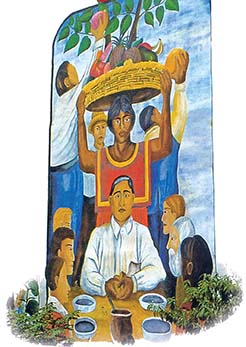SECTION 3: The Rights Revolution Expands

◄ A mural from the Philadelphia Mural Arts Program, begun in 1984, honors the great Mexican muralist, Diego Rivera (seated at center).
WITNESS HISTORY  AUDIO
AUDIO
From Graffiti to Art
Judith Baca, the daughter of Mexican immigrants, taught art in public schools in a rough Los Angeles neighborhood in the early 1970s. Between her classes, she watched young Latinos hanging out in parks and writing graffiti on the walls. Intrigued by the kids’ graffiti, she developed the idea of channeling their creative energy into painting murals. Her idea spread to other U.S. cities, where kids used murals to document and celebrate Latino culture and history. Their work was just one part of a growing movement that sought to educate, respect, and politically organize American Latinos.
Objectives
- Explain how the Latino population grew after World War I.
- Analyze the Latino and Native American rights movements of the 1960s and 1970s.
- Describe the expansion of rights for consumers and the disabled.
Terms and People
- Cesar Chavez
- migrant farmworker
- UFW
- Chicano movement
- AIM
- Japanese American Citizens League
- Ralph Nader
NoteTaking
Reading Skill: Compare and Contrast Create a Venn diagram to compare and contrast the Latino and Native American rights movements.

Why It Matters Successes in the civil rights and women’s movements signaled a growing rights revolution in the United States. Latinos, Native Americans, and Asian Americans engaged in their own struggles for equality during the 1960s and 1970s, fighting to influence laws and government. Meanwhile, activists worked to expand rights for two broad groups: consumers and people with disabilities. Section Focus Question: How did the rights movements of the 1960s and 1970s expand rights for diverse groups of Americans?
The Latino Population Grows
After World War I, the United States passed legislation limiting European immigration. Yet during and after World War II, the country faced a growing demand for cheap labor. At the same time, the populations of Mexico and other Latin American nations grew steadily while job opportunities there declined. The combination of these factors created a steady stream of new immigrants to the United States.
A Spanish-Speaking Population
People whose family origins are in Spanish-speaking Latin America are called Latinos or Hispanics. They come from many different places, but they share the same language and some elements of culture. Spanish-speaking people lived in many parts of the western United States before settlers from the United States arrived, and their numbers have grown steadily. Mexican Americans, known as Chicanos, have always made up the largest group of U.S. Latinos.




